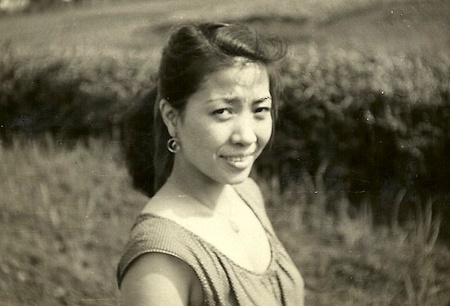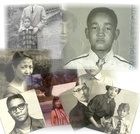Read “Part 2: The Waters [2 of 2]” >>
Watermelon seeds, 1964 Shōwa Year 39
スイカの種、1964年 昭和39年
“One of the remarkable features of this group is that it seems that all the war children receives[sic] a stigma, whether the father was an enemy soldier or an allied…We have to understand that this stigma often is associated with the status of the mother.”
—From: The War Children of the World1
Lovers—a Japanese man and the French woman, speak:
He: You saw nothing in Hiroshima. Nothing.
She: The reconstructions have been made as authentically as possible.
The illusion, it’s quite simple, the illusion is so perfect that the tourists cry…
I’ve always wept over the fate of Hiroshima. Always.
He: No. What would you have cried about?
She: I saw the newsreels…
He: You saw nothing. Nothing.
— From the film: Hiroshima mon amour (Duras and Resnais, 18-19)
So many people have all kinds of memories of World War II and Japan. Or shall I say that so many people have opinions and formations of “Japan” and “the US Occupation” or “World War II” and “postwar,” without ever having gone to Japan, or having lived in Japan during those times.
Movies of Hiroshima (usually nothing about Nagasaki or the daily bombings of Japan before the Atomb bombs were dropped) are one of the main ways in which “history” is imparted to people. Internalize, create, create opinions and positions in relation to these internalized images and words. Textbooks, our parents and relatives, our friends, the movies, the television, the billboards, the times we live in today. And then, the memories of those who experienced those times are also different depending on caste, region, race, etc.
But there are basic things. That it was a devastation, a “first” and that it has not been repeated in history (so far), is also a fact. But the memory of my mother’s country (and mine) as a symbol of the “atomic bomb” and subsequent economic miracles, is about the only driving force of memory for so many. What is the purpose of our knowledges and memory? What is it exactly that we know or presume to know? And why do we know? How do we use what we know? Who benefits and what benefits from what we know or don’t know? With what do we spend our everyday time? What is silent and therefore unchanged? I call them ghosts, accumulating…Ghosts upon ghosts.
This French woman in the dialogue above, may obliterate the horror of Hiroshima, as if this is all Hiroshima ever was—a site of America’s bomb) by knowing it as something existing in the intimacy between her and her Japanese male lover. What is ヒロシマ Hiroshima? Certainly the protests of the hibakusha —the Hiroshima Bomb survivors, are important in our world for conversations about war. But Mama is now invisible in this struggle. Mama was bombed daily. She wasn’t in Hiroshima during the rain of bombs. More people died in the daily bomb raids and there was more destruction.2 But Mama considers her story つまんない trivial/boring , according to her own words. Internalized oppressions.3 It makes for perfect citizens that are silent and get jobs and go to work and have families. Everyone supposedly knows war is horrible. It’s finished and not worth speaking about for many, or they refuse to hear and see.
One way that Mama survives in the U.S. is to internalize the assimilation of the immigrant, which began in the occupation. Mama became outsider (immigrant, oriental, Asian, Japanese, wife of a military man, “war bride,” wife of a negro-american, etc.) in the U.S. In Japan she was as well (being born in China, marrying an American serviceman, marrying a Black man). How people viewed Mama, and viewed me, and Dad, were pre-figured. Without ever knowing us or speaking to us, people speak and hear us through what has been programmed. Survival is complex. And survival as act, goes unrecognized. People think it is just “personality” or a past that is gone. Or that it is unimportant because we move on and that this past is not present. Then why did someone talk about Pearl Harbor, or tell me “Asians are dangerous” and “Hiroshima was sad” just today and the week before?
In any case, postwar Japan lives on. For most of the European and U.S. American world, the August Day in 1945, when the atomic bomb was dropped on Nagasaki and Hiroshima, Japan, it was the happy end. War no more! Joy! A celebration of kisses! For the Japanese, and the entire Pacific region, it was a continuing of struggle—perhaps changed by circumstances but going onward in new forms. Seeds planted. “New” Japan. A different U.S. New Mama, new America.
* * * * * * *
Seeds
Through much of my own childhood summers, Mama used to mention スイカの種 suika no tane : watermelon seeds . She couldn’t be bothered to spit the seeds out whenever she ate the huge juicy-red and green summer melons with those little hard black-black seeds. I copied her and didn’t spit out the seeds either. Swallowing them.
She said they had to take the seeds out of her stomach through surgery. It was that day, when I was about six or seven years old, seeing the 5-inch vertical scar that ran below Mama’s belly button like a national flag. I asked what that scar was. Suika no tane . When I was a little kid in Japan, Mama and I used to eat the great watery Japanese watermelons to cool us in the Japanese summers on the wooden veranda overlooking the garden of lilies and butterflies, sometimes together with some of Mama’s friends, or my only other close friend Ritchie and his sister and mother. Those days when I was a little one in my birth-town of Ōme, Japan, I wondered about when my surgery to remove the watermelon seeds would be.
I continued to wonder even after our family moved and moved—Ōme, Tachikawa, Murayama Heights, Washington Heights, Tachikawa Air Force Base, Albuquerque, Kirtland Air Force Base, Halawa, Aiea, Tachikawa Air Force Base again, Murayama, Shōwa, then back to Albuquerque before I was 16 years old. Living in Albuquerque, and after beginning to speak English pretty well by 8 years old, I remembered running to ask the mother of one of my Mexican-American friends from school, if I would need surgery from swallowing watermelon seeds. She laughed and said “pobrecito, no.”
Just after my 9th birthday, in a conversation over genmai-cha and osembei with Mama on a roasting mid-summer day, I became disoriented. In the previous spring:
“Futsū no umarekata ja nakatta no yo Furetto. Furetto ga umareru you ni koko kitta no yo.”
You weren’t born in the regular way Fred. I was cut here (pointing to the scar) so you could be born.
So I found out last year that it wasn’t watermelon seeds as I suspected as a little one. I was a cesarean birth. But then on this day…Mama lifted another loose-fitting shirt over and off of her upper body and I glanced once again at the vertical scar. When I stared she calmly turned to me and in a matter-of-fact tone said, leaning her face towards me like she often did—whispering to tell me a secret:
“Ne-eh Fretto. Fretto wa mou ōkiku nattakara yuukedo, Fretto wa futago no ko datta no yo. Fretto ni toshi-ue no o-nē-san ga ita no yo. Shinjatta kedo…” then she slightly turned her head to look away into the distance. I…I gulp. Now that I, Fredrick, am older—she says, it’s time to tell me that I was one of a twin and that I had a Twin Sister. And she died…died.
Not only was I born through cesarean, there is now a dead twin sister in the room.
Notes:
1. The War Children of the World is a report of the War and Children Identity Project, Bergen, December 2001 by Kai Grieg.
2. I will get to more of these facts later in this book.
3. For more on internalized oppression, see Cudd, Ann E. 2006. Analyzing Oppression . Oxford: Oxford University Press or Hobgood, Mary Elizabeth. 2000. Dismantling Privilege: An Ethics of Accountability . Cleveland, OH: Pilgrim Press.
This is an anthropology of memory, a journal and memoir, a work of creative non-fiction. It combines memories from recall, conversations with parents and other relations, friends, journal entries, dream journals and critical analysis.
To learn more about this memoir, read the series description.
© 2011 Fredrick Douglas Cloyd







